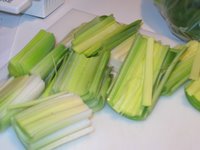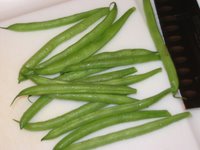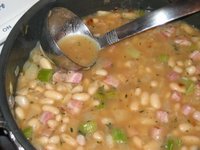Pig and Truffle Dinner by Chef Bradford Thompson at the James Beard House
 A couple weeks ago I made it back to the James Beard House for a Pigs and Truffle dinner by chef Bradford Thompson. Thompson is currently the chef at Mary Elaine’s at the Phoenician hotel in Scottsdale, Arizona. Prior to the Phoenician, Thompson was in New York working for Daniel Boulud—my favorite chef.
A couple weeks ago I made it back to the James Beard House for a Pigs and Truffle dinner by chef Bradford Thompson. Thompson is currently the chef at Mary Elaine’s at the Phoenician hotel in Scottsdale, Arizona. Prior to the Phoenician, Thompson was in New York working for Daniel Boulud—my favorite chef.Evidently Thompson is one of the premiere chefs of meat. In fact, he takes his meats so seriously that he acquires all his meat from Sylvia and Stephen Pryzant of Four Story Hill Farm in Honesdale, PA. This evening was no exception. In preparation, the Four Story Hill Farm had raised two pigs specifically for this dinner. To accompany the various pork dishes, Thompson also incorporated truffles. How can you go wrong with pork and truffles???
 Out of our foursome group attending this dinner, I was of course the first one to arrive—you have to be early to get the best dibs on hors d’oeuvres and who can turn down free flowing champagne! Since I was on my own at this point, I made my way into the kitchen area to watch the chefs in action. Although the kitchen area is open for guests to watch, it does tend to get crowded. I was lucky and found not only a little nook, but a nook that happened to be right next to where Chef Thompson himself was hanging out.
Out of our foursome group attending this dinner, I was of course the first one to arrive—you have to be early to get the best dibs on hors d’oeuvres and who can turn down free flowing champagne! Since I was on my own at this point, I made my way into the kitchen area to watch the chefs in action. Although the kitchen area is open for guests to watch, it does tend to get crowded. I was lucky and found not only a little nook, but a nook that happened to be right next to where Chef Thompson himself was hanging out.Of course Thompson was sexy (aren’t all chefs?), but he was also really nice. Okay, so I spoke like two sentences with him, but he kindly offered me an hors d’oeuvre before they were handed out to the crowd and then explained to me how I should eat it to fully appreciate the flavors. Okay, so that was really like five sentences we shared. Gosh, I am such a foodie dork!
The following were the hors d’oeuvres and champagne that were served:

Burgundy Snail Croquettes
Pork Consommé Dumplings
Sicilian-Style Rice Balls
Garlicky Sausage and White Bean Purée
Deviled Quail Eggs with Black Truffles
Lobster and Brioche BLTs
Veuve Clicquot Ponsardin Rosé Réserve Champagne 1999
Hands down, my favorite was the pork consommé dumplings. Unfortunately there were not many of those and I only had one, but it was extremely flavorful. The dumpling was served in a large serving spoon to ensure that all the juices were captured in that one bite. I also loved the gumminess of the dough with the pork.
When it was time to be seated, we found on our chairs little gift bags! This is not the norm for dinners at the James Beard House, but the Phoenician hotel provided them to encourage us to visit them the next time we are in Scottsdale. I included a picture here of what was included (note that the cat paw comes separately).

After we were settled at our tables, the following dishes and wine pairings were served:
Tasting Plate of Charcuterie
Domaine de Longval Tavel Rosé 2004
Spanish Toro with Warm Truffle Anglaise, Marinated Crudités,
and Pork Rinds
F. E. Trimbach Riesling Cuvée Frédéric Emile 2000
Pizzoccheri Ravioli with Fresh Garlic Sausage, Fontina Valle
d’Aosta, and Sage
Livio Felluga Terre Alte 2003
Walnut-Crusted Pork Loin Schnitzel with Braised Red Cabbage and Porcini
Domaine Bouchard Père & Fils Volnay Caillerets Ancienne Cuvée Carnot 2000
Smoked Confit of Pork Belly and Jowl with Anson Mills Grits and Maple-Glazed Turnips
Château La Nerthe Châteauneuf-du-Pape 2003
Caramelized Apple Napoleon > Fresh Lard Biscuit, Candied Chestnut, and Chestnut Cream
Domaine Dupont Pommeau de Normandie NV
Warm Apple Cider Doughnuts with Black Truffle–Chocolate Sauce
Wow, how lucky was I? And get this—I ate all sorts of parts of the pig and they were actually good! Yes, yours truly ate tongue, ear, jowl, meat from the feet, and I am sure many other parts that I do not know about! The tongue was very mellow in flavor, and since it was sliced so thinly, I was not bothered by the texture that I picture tongue as having.
Of course all the dishes were fabulous. I think my favorites were the ravioli with fresh garlic sausage and the smoke confit of pork belly. Unfortunately, my pork belly was actually overcooked, but it still made my belly happy (ha, ha!).
As explained in my last post about a dinner I had at the James Beard House, the events always end with the chef joining the diners and answering any questions. I love this part! This time I had the guts to take a picture too so you can get a feel of the atmosphere. See what embarrassment I subject myself to for the sake of my beloved readers?!

So all in all, it was a fabulous dinner and, of course, such a treat.
Labels: James Beard, New York







































 Until you cut open your prized watermelon, you should keep it at room temperature. However, once you have cut into it, you should cover it with plastic wrap and keep the melon refrigerated.
Until you cut open your prized watermelon, you should keep it at room temperature. However, once you have cut into it, you should cover it with plastic wrap and keep the melon refrigerated.
